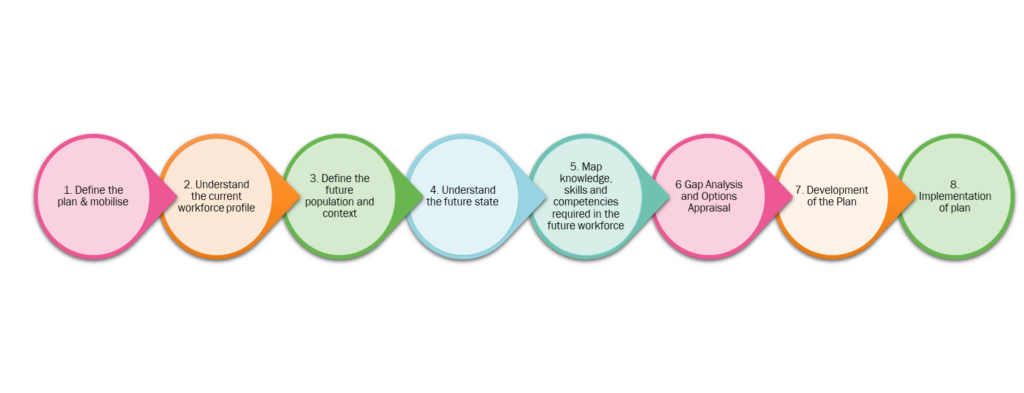In her last news and views article, Dianna introduced herself as Workforce Offer Lead at the TU and talked about the importance of workforce in the work we carry out for our clients.
This article expands on the methodology that we use for workforce planning. If you would like to know more about the TU workforce offer and how we could support you, then please get in touch.
Context
NHS England articulates through both the NHS Long Term Plan and NHS Long Term workforce plan the importance of effective workforce planning to ensure we are able to deliver safe, high-quality care to patients and service users. Creating an effective workforce requires an evidence-based workforce plan, integrated with finance, activity and strategic plans so we have a sustained and responsive workforce that reflects changes in demand, services and wider factors.
With this in mind, our approach can be adopted as part of a workforce planning project at a provider, place or system level or be integrated as part of wider clinical redesign and transformation programme approaches. Our workforce planning approach is part of our Workforce Transformation support.
Value
Our strategic workforce planning approach allows the future workforce to be more effectively planned by using a combination of engagement, analytics and workforce / OD techniques:
- Our analytics capability ensures population health, current demand and workforce profile is translated into future workforce requirements
- Our OD and engagement experience, including HEE Star trained practitioners, allows us to explore not just the future WTE but also how we respond to the need to train, retain and reform
The TU can provide a bespoke team to meet your skills requirements, with a specialist team of workforce, HR, analysts, clinical, engagement and transformation consultants to draw upon.
We can adapt our approach and project team dependent on the purpose and scope of your workforce plan and the capacity and capability of your organisation.
Methodology

- Define the plan and mobilise
It is important to first identify the purpose, scope, and key lines of enquiry for the workforce plan. We agree our approach and project management arrangements, including ownership and key responsibilities. We also build an understanding of wider transformation work to ensure our work aligns with this. - Understand the current workforce profile
We agree the scope of the workforce baseline to ensure we develop a full profile of the current workforce. We work with key stakeholders to collate, analyse, and present the required data. During a stakeholder workshop, we then evaluate the current workforce and explore ambitions for the future workforce. ambitions for the future workforce. - Define the future population and context
This step is focused on developing a comprehensive population profile and context summary. With consideration for the wider determinants of health and broader socio-economic factors it ensures we consider how workforce design can impact health inequalities and population health outcomes.To understand the future population demand, we engage partners and combine information from a literature review and data intelligence. We can then understand our current and future workforce capacity alongside current activity analysis.
- Understand the future state
During this phase, we yield intelligence from stakeholders on the design of future services and pathways and the future population demand. We can also provide clinical redesign support at this stage if required.
- Map knowledge, skills & competencies required in the future workforce
Through stakeholder workshops, we:
- Develop workforce vision and design principles;
- Assess the skills, knowledge and competencies required to deliver the future service.
- Gap analysis and options appraisal
Using demand intelligence, current workforce baseline and future service design, we then identify the workforce requirements for the future. Through OD techniques, including Health Education England (HEE) Star approach, we explore the workforce transformation enablers to meet the future service and demand requirements, generating a series of options. An options appraisal is undertaken with stakeholders to agree priorities. - Development of plan
At this stage, we combine the outputs from the previous phases to develop the future workforce plan. This includes developing an action plan with key stakeholders.
- Implementation of plan
If required, we can draw on our other areas of expertise including our project and programme management skills to implement the workforce plan.
How we can help you
If you have a transformation programme and you’d like to discuss how we can help, please get in contact. As part of NHS Midlands & Lancashire we have access to great range of expertise whether that be strategic planning, business cases, clinical redesign or complex programme management.
E: transformationunit@nhs.net
W: https://transformationunit.nhs.uk/
L: https://www.linkedin.com/company/transformationunit/
X: https://twitter.com/tu_nhs